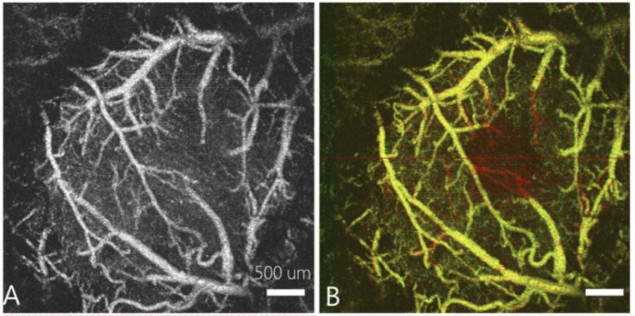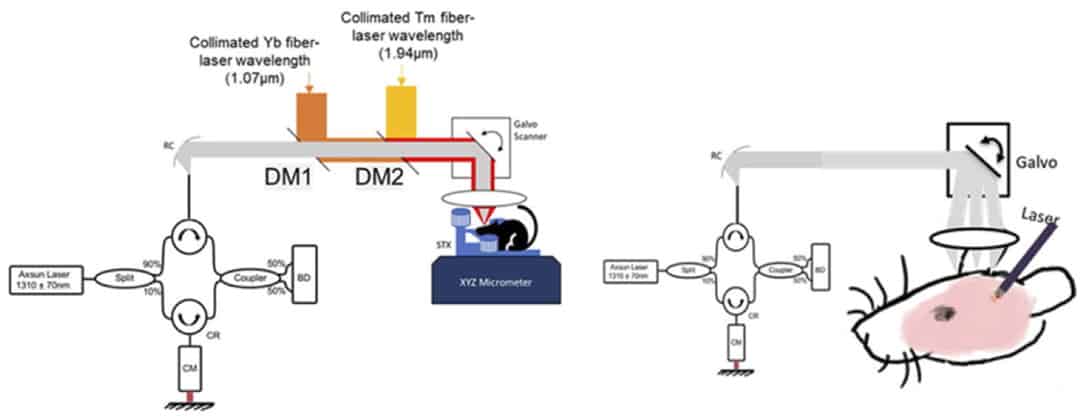
A dual-wavelength fibre-laser platform designed for bloodless brain tissue resection has been developed by researchers at the UCI Beckman Laser Institute & Medical Clinic and the University of Texas at Austin. Configuration of the platform for clinical use will enable neurosurgeons to rapidly remove brain tumours, forming the basis of a flexible cutting tool for precision tissue resection.
Inadvertent damage to blood vessels during neurosurgery can obscure the surgeon’s field-of-view. Thus a blood-free environment during surgical resection would make brain surgery more precise and safer. The surgical tools currently used in brain surgery to maintain a blood-free surgical field are ultrasonic aspirators followed by electrocautery. But because these are used sequentially, operating room times can be lengthy. In addition, the electrocautery tool can compromise neural function by damaging viable tissue.
As an alternative, the researchers demonstrated the use of their novel surgical fibre-laser for blood-free neurosurgical resection in mice. The platform combines microscopic-resolution optical coherence tomography (OCT) for image guidance, a vascular specific 1.07 µm ytterbium fibre-laser for blood vessel coagulation, and a precise thulium fibre-laser to perform bloodless cutting.
The ytterbium laser has a peak power of 3000 W, with variable pulse repetition rate and versatile pulse durations (50 µs to 200 ms) for coagulation of different sized blood vessels. The thulium laser, which operates at the 1.94 µm water absorption peak, was used at 15 W average power for tissue resection. The team combined both fibre-lasers into a single biocompatible silica fibre, guided by the swept-source OCT system centred at 1310±70 nm.

The team used the dual-wavelength platform to perform in vivo laser surgery, including point, line and square ablations, on five mice placed on a cranial stereotaxic stage. This involved an initial OCT imaging step, a series of image-guided ablations and coagulations, and post-ablation OCT imaging. OCT angiography was carried out before and after each procedure to verify the tissue resection.
“Development of the fibre laser platform was enabled by two key scientific advances,” principal investigator Thomas Milner, director of the Beckman Laser Institute, tells Physics World. “The first is the laser dosimetry required to coagulate blood vessels of variable sizes. Large calibre blood vessels (250 µm or larger) have previously evaded laser coagulation due to fast flowing blood. My colleague Nitesh Katta worked out the scientific rationale for establishing the laser dosimetry to coagulate blood vessels up to 1.5 mm in diameter.”
The second advance, Milner explains, is a preconditioning methodology that allows repeatable and consistent tissue ablation in many tissue types with deeper penetrating lasers. “Because laser ablation is dependent on tissue mechanical properties, cutting can be inconsistent and in some cases can result in a catastrophic thermal runaway. The platform developed resolves these problems and allows repeatable and consistent cutting of both soft and even stiff tissues such as cartilage.”
Writing in Biomedical Optics Express, the researchers report that post-surgical ablation resulted in repeatable and consistent tissue cuts, while the surgical field remained entirely bloodless. The cuts correlated qualitatively with histological sections in terms of size, shape and morphology, with minimal observed thermal damage. The Milner lab team believes that this is the first time that bloodless resection of brain tissue has been achieved using a dual-wavelength strategy, with a pulsed thulium fibre laser for resection and a vascular-specific wavelength for coagulation combined into a single beam path.

Biopsy needle makes brain surgery safer
“We are currently trying to build a small-form-factor malleable bloodless optical fibre knife that can resect neurologic tissue with minimal lateral thermal spread,” says Katta. “For this, we are using a dual-wavelength approach to overcome the competing requirements of haemostasis and tissue resection. One wavelength is tuned to a blood absorption wavelength. The second wavelength is tuned to water absorption to remove tissue in an efficient way.”
Katta notes that recent developments in fibre-lasers (for example, thulium and ytterbium) and fibre-coupled diode lasers (near-infrared), combined with the latest advances in high-power fibre-optic components, provide an even wider choice of wavelengths to combine multiple beams into a small-form-factor optical fibre.



